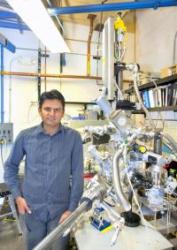A team of researchers at the U.S. Department of Energy's Lawrence Berkeley National Laboratory has discovered that semiconductor nanocrystals called quantum dots can display plasmonic properties.
According to the Berkeley Lab director Paul Alivisatos, localized surface plasmon resonances emerging from p-type carriers in semiconductor quantum dots that are vacancy-doped lead to plasmonic sensing and management of solid-state procedures in individual nanocrystals. The doped quantum dots could enable coupling of photonic and electronic properties for applications in light harvesting, nonlinear optics, and quantum data processing.
 Berkeley's Prashant Jain
Berkeley's Prashant Jain
Light in sizes smaller than the wavelengths of photons in free space causing various lengths related to photonics and electronics to match in an individual nanoscale device is called plasmonics. The team says this technology could help develop computer chip interconnects that can maneuver large amounts of information rapidly. It could also help develop microscope lenses to view nanoscale materials with visible light, light generating diodes, and highly sensitive chemical and biological sensors. The materials could also help wrap light around an object, making it invisible.
Jain says any nanostructure could display localized surface plasmon resonance (LSPR) until the interface has free charge carriers, which could be either electrons or holes. The team developed the quantum dots from semiconductor copper sulfide that supports stoichiometries that lack copper. The copper sulfide nanocrystals were first synthesized with hot injection. This created nanocrystals that were self-doped with p-type charge carriers without control over charge vacancies or carriers. This limitation was solved with room-temperature ion exchange method that synthesized the nanocrystals. This froze the nanocrystals into a vacancy-free condition that could be doped in a controlled method with chemical oxidants. Introducing free electrical charge carriers through dopants and vacancies helped achieve LSPRs in the near infrared range of the electromagnetic spectrum. Using photons, such as quantized plasmons, would allow data transmission at the speed of light.
Alivisatos has co-authored the paper titled. ‘Localized surface plasmon resonances arising from free carriers in doped quantum dots,’ that recently appeared in the Nature Materials. Other writers included Joseph Luther, Prashant Jain, and Trevor Ewers.